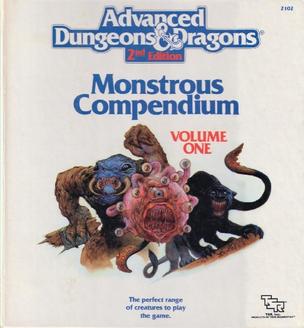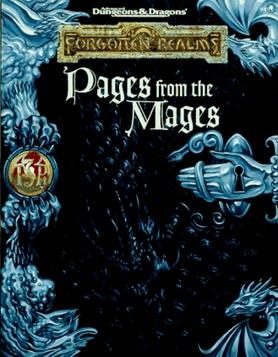 Cover of the first edition | |
| Genre | Role-playing game |
|---|---|
| Publisher | TSR |
Publication date | 1995 |
| Media type | |
Chronomancer is a supplement to the 2nd edition of the Advanced Dungeons & Dragons fantasy role-playing game.
 Cover of the first edition | |
| Genre | Role-playing game |
|---|---|
| Publisher | TSR |
Publication date | 1995 |
| Media type | |
Chronomancer is a supplement to the 2nd edition of the Advanced Dungeons & Dragons fantasy role-playing game.
Chronomancer presents rules for a wizard class which specializes in time-related magic, and presents new spells. [1]
Chronomancer was originally developed for Mayfair Games. In 1991, TSR, Inc. sued Mayfair for violating a trademark agreement made between the two companies in 1984. In 1993, TSR "came to another out-of-court agreement with Mayfair. Since Mayfair was at the time on their way out of the roleplaying business, they sold the entire Role Aids line to TSR... including some unpublished manuscripts, one of which was to become Chronomancer. Chronomancer might have been intended as part of a new magic-user line for Role Aids, spinning out of their Archmagic (1993) box set". [2] [3]
The Mayfair "manuscript was originally scheduled to be written by Lisa Stevens and Vic Wertz" but after Stevens' freelance contract was bought out by Wizards of the Coast, the project ended up being written by Loren Coleman. After TSR bought Mayfair's Role Aids line, Matt Forbeck developed the unpublished manuscript and "brought it more in tune with TSR's publications". In August 1995, the supplement was published. [2] [3]
Trenton Webb reviewed Chronomancer for Arcane magazine, rating it a 7 out of 10 overall. [1] Webb comments that "Chronomancer sets up a wizard class that specialises in leaping around in time and not being seen." [1] He noted that the chronomancer's spell list "seems underpowered at first, yet its true power (spookily in character, this) only becomes apparent after time. Far sooner than non-specialist mages, chronomancers get their hands on serious spells that, when used precisely, cause major carnage [...] Such spells are dangerous, and the referee is offered control over their impact by the manual's split player/ref structure. Secondary spell descriptions are provided for the referee's benefit and open up some truly entertaining roleplay possibilities: when a chronomancer tries a new spell, he has only a rough idea of its ramifications." Webb concludes his review by saying: "With such a complex idea as messing with time there are inevitably grey areas, and this may discourage some from dabbling; but those who dare will be rewarded with a game in which both the PCs and the referee can be truly surprised." [1]

Mystara is a campaign setting for the Dungeons & Dragons fantasy role playing game. It was the default setting for the "Basic" version of the game throughout the 1980s and 1990s. Most adventures published for the "Basic" edition of D&D take place in "The Known World", a central continent that includes a varied patchwork of both human and non-human realms. The human realms are based on various real-world historical cultures. In addition, unlike other D&D settings, Mystara had ascended immortal beings instead of gods.

The Monstrous Compendium is a series of accessories for the Advanced Dungeons & Dragons fantasy role-playing game released from 1989 to 1998. The title was then used for a series of 5th Edition Dungeons & Dragons supplements released on D&D Beyond.
Richard Baker is an American author and game designer who has worked on many Dungeons & Dragons campaign settings.
The magic in Dungeons & Dragons consists of the spells and magic systems used in the settings of the role-playing game Dungeons & Dragons (D&D). D&D defined the genre of fantasy role-playing games, and remains the most popular table-top version. Many of the original concepts have become widely used in the role-playing community across many different fictional worlds, as well as across all manner of popular media including books, board games, video games, and films.
Mayfair Games was an American publisher of board, card, and roleplaying games that also licensed Euro-style board games to publish them in English. The company licensed worldwide English-language publishing rights to The Settlers of Catan series between 1996 and 2016.
The wizard is one of the standard character class in the Dungeons & Dragons fantasy role-playing game. A wizard uses arcane magic, and is considered less effective in melee combat than other classes.

The Complete Book of Humanoids is a sourcebook for the second edition of the Advanced Dungeons & Dragons fantasy adventure role-playing game.

Dungeon Master Option: High-Level Campaigns is a supplemental sourcebook to the core rules of the 2nd edition Advanced Dungeons & Dragons (AD&D) fantasy role-playing game.

Dark Sun is an original Dungeons & Dragons (D&D) campaign setting set in the fictional, post-apocalyptic desert world of Athas. Dark Sun featured an innovative metaplot, influential art work, dark themes, and a genre-bending take on traditional fantasy role-playing. The product line began with the original Dark Sun Boxed Set released for D&D's 2nd edition in 1991, originally ran until 1996, and was one of TSR's most successful releases.

The Gates of Firestorm Peak is an adventure module for the second edition of the Advanced Dungeons & Dragons fantasy role-playing game. The adventure was published in 1996, and was written by Bruce Cordell, with cover art by Jeff Easley and interior art by Arnie Swekel.
Julia Martin is a game designer and editor who has worked on a number of products for the Dungeons & Dragons fantasy roleplaying game.

Pages from the Mages is an accessory for the 2nd edition of the Advanced Dungeons & Dragons fantasy role-playing game, published in 1995.

Shaman is an accessory for the 2nd edition of the Advanced Dungeons & Dragons fantasy role-playing game, published in 1995.

Player's Option: Spells & Magic is an accessory for the 2nd edition of the Advanced Dungeons & Dragons fantasy role-playing game, published in 1996.

Requiem: The Grim Harvest is an accessory for the 2nd edition of the Advanced Dungeons & Dragons fantasy role-playing game, published in 1996.

A Guide to the Astral Plane is an accessory for the 2nd edition of the Advanced Dungeons & Dragons fantasy tabletop role-playing game, published in 1996.

Forged of Darkness is an accessory for the 2nd edition of the Advanced Dungeons & Dragons fantasy role-playing game, published in 1996.

Defilers and Preservers: The Wizards of Athas is an accessory for the 2nd edition of the Advanced Dungeons & Dragons fantasy role-playing game.

Netheril: Empire of Magic is an accessory for the 2nd edition of the Advanced Dungeons & Dragons fantasy role-playing game, published in 1996.
Role Aids is a line of role-playing game supplements published by Mayfair Games starting in 1982 intended for use with Advanced Dungeons & Dragons.